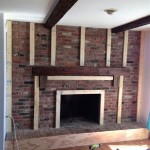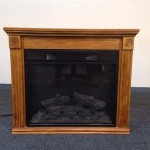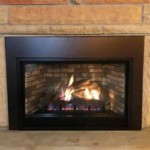Tempered Glass Fireplace: Safety, Aesthetics, and Functionality
Fireplaces have long been a cornerstone of home heating and ambiance, evolving through various designs and technologies. The tempered glass fireplace represents a modern iteration, prioritizing both safety and aesthetic appeal. Tempered glass, known for its enhanced strength and breakage properties, plays a crucial role in the construction and operation of these fireplaces, offering a protective barrier while maintaining a clear view of the flames.
This article will explore the characteristics of tempered glass fireplaces, focusing on their safety features, aesthetic contributions, and functional considerations. This includes an examination of the manufacturing process of tempered glass, its specific applications within fireplace designs, and the benefits it provides over alternative materials. Understanding these aspects is crucial for homeowners and designers seeking to incorporate a safe and visually appealing heat source into residential spaces.
Understanding Tempered Glass
Tempered glass, also known as safety glass, undergoes a specialized heat treatment process to increase its strength and alter its breakage pattern. The process involves heating the glass to a near-melting point and then rapidly cooling the surfaces while allowing the core to cool more slowly. This differential cooling creates a state of high compression on the surface and tension in the interior.
This inherent stress distribution gives tempered glass several important properties. Firstly, it is approximately four to five times stronger than annealed or regular glass of the same thickness. This increased strength makes it far more resistant to impact, pressure, and thermal stress. Secondly, when tempered glass does break, it shatters into small, relatively harmless fragments rather than sharp, jagged shards. This reduces the risk of serious injury, making it a preferred material in applications where safety is paramount.
The properties of tempered glass are directly related to its manufacturing process. Any alteration or cutting of the glass must be performed before the tempering process, as any subsequent modification can compromise its structural integrity and cause it to shatter. This characteristic is a crucial consideration in the design and installation of tempered glass fireplaces.
Safety Features of Tempered Glass Fireplaces
The primary advantage of using tempered glass in fireplaces is the enhanced safety it provides. Traditional fireplaces without proper shielding can pose significant risks, including accidental contact with flames or hot surfaces. Tempered glass acts as a protective barrier, preventing direct contact with the fire and reducing the risk of burns.
Furthermore, tempered glass offers increased resistance to thermal shock. Rapid temperature fluctuations can cause ordinary glass to crack or shatter, especially in the vicinity of a fireplace. The tempering process improves the glass's ability to withstand these temperature changes, ensuring its durability and longevity in the demanding environment of a fireplace.
In the event of accidental breakage, the shattering pattern of tempered glass significantly minimizes the risk of serious injury. The small, blunt fragments are less likely to cause deep cuts compared to the sharp shards produced by broken annealed glass. This feature is particularly important in homes with children or pets, where the risk of accidental contact with the fireplace is higher. Building codes often mandate the use of tempered glass in fireplace applications to ensure compliance with safety standards.
Aesthetic Contributions and Design Considerations
Beyond its safety benefits, tempered glass significantly enhances the aesthetic appeal of fireplaces. Its transparency allows for an unobstructed view of the flames, creating a focal point in the room. This clear visibility is particularly desirable in modern fireplace designs that prioritize a minimalist and contemporary aesthetic.
Tempered glass panels can be incorporated into various fireplace designs, including freestanding models, wall-mounted units, and built-in installations. The glass can be configured as a full enclosure, a partial shield, or a decorative accent, depending on the desired aesthetic effect. The versatility of tempered glass allows designers to create custom fireplace solutions that complement the overall style of the living space.
Furthermore, tempered glass is relatively easy to clean and maintain. Its smooth surface can be wiped down with standard glass cleaners to remove soot, dust, and fingerprints. This simplifies the cleaning process and ensures that the glass remains clear and transparent, maximizing the visual impact of the flames. The use of specialized glass cleaners formulated for fireplace applications can further enhance the clarity and longevity of the tempered glass.
The thickness of the tempered glass used in a fireplace is a critical factor in both safety and aesthetics. Thicker glass provides greater structural integrity and thermal resistance, but it can also affect the transparency and visual clarity. Designers must carefully consider the balance between these factors when selecting the appropriate glass thickness for a particular fireplace design. The size of the glass panel also influences the required thickness; larger panels necessitate thicker glass to maintain structural stability.
The framing around the tempered glass can also significantly impact the overall aesthetic. Minimalist frames, often made of stainless steel or powder-coated metal, create a clean and contemporary look. More traditional frames, constructed from wood or stone, can add a rustic or classic feel. The choice of framing material should complement the overall design of the fireplace and the surrounding room.
Functional Considerations and Installation
The efficiency of a tempered glass fireplace is influenced by several factors, including the design of the fireplace, the type of fuel used, and the ventilation system. While tempered glass itself does not directly improve heating efficiency, it can contribute to better heat distribution by preventing drafts and creating a more contained combustion chamber.
Proper installation is crucial for ensuring the safe and efficient operation of a tempered glass fireplace. The installation process should be carried out by qualified professionals who are familiar with the specific requirements of the fireplace model and local building codes. This includes ensuring proper venting, adequate clearance from combustible materials, and secure mounting of the tempered glass panels.
Maintenance is also an important consideration. Regular cleaning of the tempered glass is necessary to maintain its transparency and prevent the buildup of soot and grime. It is also important to inspect the glass periodically for signs of damage, such as cracks or chips. Any damaged glass should be replaced immediately to prevent potential safety hazards.
The type of fuel used in the fireplace can also affect the performance and longevity of the tempered glass. Burning clean-burning fuels, such as natural gas or propane, produces less soot and minimizes the risk of discoloration or damage to the glass. Wood-burning fireplaces require more frequent cleaning of the glass to remove soot buildup. The choice of fuel should be carefully considered based on factors such as cost, availability, and environmental impact.
Ventilation is another critical factor in the operation of a fireplace. Proper ventilation ensures that combustion gases are safely exhausted from the home, preventing the buildup of carbon monoxide and other harmful pollutants. The ventilation system should be designed and installed according to local building codes and manufacturer's recommendations. A well-designed ventilation system also helps to maintain a comfortable indoor air quality and prevent drafts.
The integration of tempered glass into fireplace design represents a significant advancement in safety and aesthetics. By understanding the properties of tempered glass, its applications in fireplace construction, and the importance of proper installation and maintenance, homeowners and designers can create a safe, visually appealing, and functional heat source for residential spaces.

Sirius Bio Ethanol Wall Mounted Fireplace With Tempered Glass Biocheminée

2 Door Steel Fireplace Fire Screen With Tempered Glass Accents Black Com

Barton 46 In W X 33 H 1 Panel Clear Gold Fireplace Screen Guard Tempered Glass Spark 95059 The Home Depot

Barton Fireplace Screen Panel 36 X 26 Inch Tempered Glass Guard Fence Stand 95057 Gold Clear Com

Uniflame Large Gerri Black Cabinet Style Fireplace Doors With Smoke Tempered Glass Ufpdl1307blk The Home Depot

Cheminée Bio Ethanol De Table Design Et Moderne

Fireplace Tempered Glass Panel Bs3913 Tx 4949 China Made In Com

We Have Pyro Ceramic And Tempered Glass For Fireplaces Clifton Park Mirrors

What Are The Causes Of Glass Shattering In A Gas Fireplace Architects Diary

Barton 39 In W X 29 H 1 Panel Clear Gold Fireplace Screen Guard Tempered Glass Spark 95058 The Home Depot
Related Posts








